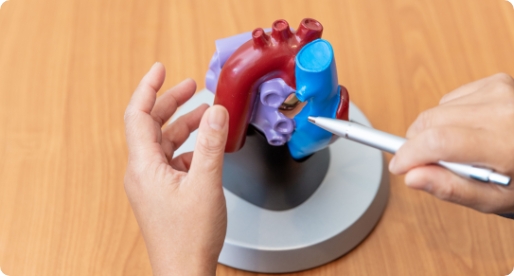Coronary Angiogram
What is a Coronary Angiogram?
A coronary angiogram (also called a cardiac catheterisation) is a special procedure that takes moving x-ray pictures of your heart.
The test is done in a special laboratory called a cardiac catheterisation laboratory (cath lab), which is similar to an operating theatre.
A thin, hollow plastic tube (called a catheter) is threaded through the largest artery in your body (the aorta) via the wrist or the groin artery until it reaches the coronary arteries of the heart. A special x-ray sensitive dye (contrast) is injected, and dynamic x-rays are taken of the blood vessels as the contrast moves through them.

What is the purpose of a Coronary Angiogram?
The purpose of this procedure is to see if your coronary arteries are narrowed or blocked and to look for abnormalities of your heart muscle or heart valves.
Apart from diseased coronary arteries, an angiogram can also diagnose a range of heart problems including aneurysm (abnormal ballooning of the heart wall), heart arrhythmias (irregular heart beat) or birth defects, such as a hole in the heart.
What are the risks of a Coronary Angiogram?
While serious risks are unlikely, there are some risks associated with a coronary angiogram procedure. The most common risk for this procedure is bruising or swelling at the puncture site.
Uncommon risks can include:
- Allergic reaction to the X-ray dye and medications given during the procedure
- Heart attack or stroke
- Bleeding
- Infection
- Abnormal heart rhythms, called arrhythmias
- Injury to the artery
- Reduced kidney function
- Emergency heart surgery
- Death from this procedure is rare
We will explain all the risks in detail before you agree to the surgery. You are also encouraged to discuss any questions or concerns with your medical team. We will ask you to sign a consent form to agree to have the procedure.

What happens during a Coronary Angiogram?
Your coronary angiogram takes place in a hospital room that looks like an operating theatre. You will be taken to the procedure room and be asked to lie on a narrow table. You will be awake throughout the procedure, and before it begins your doctor may offer you sedation to help you relax. During the procedure, your doctor will:
- Give you a local anaesthetic - to numb your wrist or groin.
- Gently insert a catheter into an artery in your wrist or groin - and move it inside the artery up to your heart.
- Inject a dye into your arteries - you may feel a warm flush when this happens.
- Take x-rays as the dye moves through the blood vessels - to clearly see where the arteries are narrowed or blocked.
- Remove the catheter - and apply pressure to the site where it was inserted.
You will be connected to a heart monitor for the duration of your coronary angiogram. The procedure takes less than hour.
What happens after a Coronary Angiogram?
Following the procedure, you will be moved to a recovery area to rest. You may be tender or sore and have some bruising at the site of the procedure – this should go away after two weeks. Based on what the coronary angiogram reveals, your doctor will recommend the best treatment for you. This may include further intervention, which would require a further hospital stay. Otherwise, after a few hours rest you will be allowed to go home. You will need to organise for someone to pick you up from the hospital afterwards and take you home.

